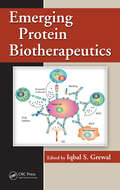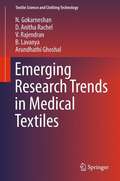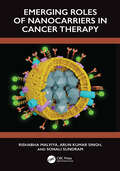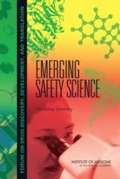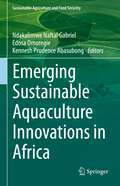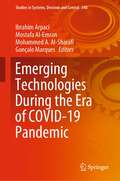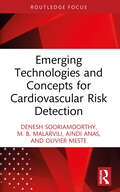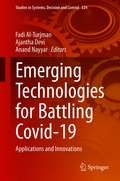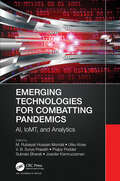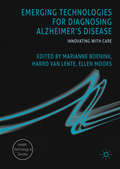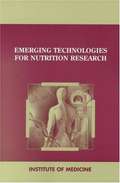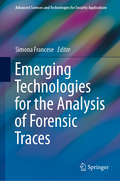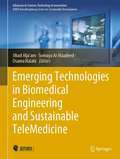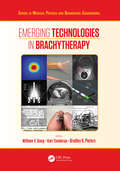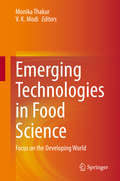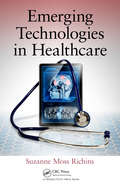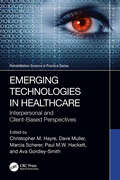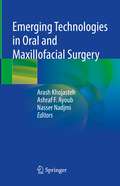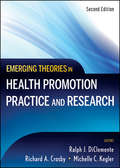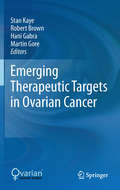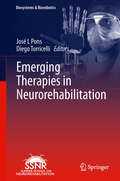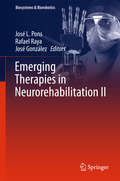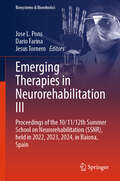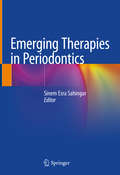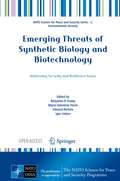- Table View
- List View
Emerging Protein Biotherapeutics
by Iqbal S. GrewalGiven the speed at which antibody therapy is becoming readily accepted, a comprehensive industry guide is sorely needed. Written by leading international authorities, this book maintains an overall emphasis on various therapeutic approaches and applications and provides critical discussions on the most significant areas of research in biologics. It focuses on the applications of protein biologics in autoimmunity and inflammation, hematological malignancies, and solid tumors. Each chapter clearly presents the most informative and contemporary account of its subject available, making this an unrivaled reference source beneficial to those in both academia and biotechnology industries.
Emerging Research Trends in Medical Textiles
by N. Gokarneshan D. Anitha Rachel V. Rajendran B. Lavanya Arundhathi GhoshalThis book provides a comprehensive review of the significant researches reported during the recent years in the field of medical textiles. It also highlights the use of new types of fibres in developing medical textile products and their promising role in the respective areas of application. Considerable developments have taken place in the development of medical textiles for varied applications.
Emerging Roles of Nanocarrier in Cancer Therapy
by Arun Kumar Singh Rishabha Malviya Sonali SundramThis book addresses the limitations of existing therapeutic approaches using nanoparticles. Emerging Roles of Nanocarriers in Cancer Therapy will further provide information for the development of successful cancer nanomedicine therapies.Features Explains different types of nanoparticles, targeting mechanisms, and approved nanotherapeutics for oncological implications in cancer treatment. Covers in detail the characteristics of various nanotechnology-based drug delivery systems. Discusses passive and active cellular targeting, ligand-based targeting of nanoparticles, and strategies to improve nanoparticle-cellular membrane interaction. Presents the application of nanotherapeutics, current challenges, and prospects, and describes the path of future research. Highlights smart strategies for improving the clinical impact of cancer nanomedicine. The text is primarily written for graduate students, and academic researchers in the fields of biotechnology, nanotechnology, drug delivery, pharmaceutical science, and pharmacology.
Emerging Safety Science: Workshop Summary
by Institute of Medicine of the National AcademiesThe National Academies Press (NAP)--publisher for the National Academies--publishes more than 200 books a year offering the most authoritative views, definitive information, and groundbreaking recommendations on a wide range of topics in science, engineering, and health. Our books are unique in that they are authored by the nation's leading experts in every scientific field.
Emerging Sustainable Aquaculture Innovations in Africa (Sustainability Sciences in Asia and Africa)
by Ndakalimwe Naftal Gabriel Edosa Omoregie Kenneth Prudence AbasubongThis edited book presents the emerging sustainable innovations in all areas of aquaculture in Africa with a view to create an opportunity whereby scientific outputs and recommendations can be endorsed for improved aquaculture outputs towards poverty alleviation and food security on the continent. Food insecurity and poverty are some of the challenges faced on the African continent. These challenges are further exacerbated by the growing human population and the impacts of climate change. Today, aquaculture has become one of the fastest food producing sectors in the world, with the potential to contribute significantly to food security and poverty alleviation in developing countries. In Africa, aquaculture is at an infant stage, however, many African countries have recognized the potential roles of aquaculture in food security, poverty alleviation and conservation of aquatic resources through their commitment to achieve the United Nation Sustainable Development Goals. The book reviews and synthesize research work from these thematic areas across Africa and provide a unique perspective on the emerging aquaculture innovations and illustrate how aquaculture practices could be feasible and cost effective while promoting social and environmental sustainability. The book also draws from global discussions on sustainable aquaculture practices and provides recommendations on what is feasible for Africa. This book is a great tool for the university students, scholars, aquaculture farmers, investors, and policymakers to understand the scientific based sustainable aquaculture innovations from an African perspective. This book is focused on SDG 2 and SDG 14.
Emerging Technologies During the Era of COVID-19 Pandemic (Studies in Systems, Decision and Control #348)
by Mostafa Al-Emran Gonçalo Marques Ibrahim Arpaci Mohammed A. Al-SharafiThis book tackles the recent research directions in using the newly emerged technologies during the era of COVID-19 pandemic. It mainly focuses on using emerging technologies and their impact on health care, education, and society. It also provides insights into the current challenges and constraints in using technologies during the era of COVID-19 pandemic and exposes new opportunities for future research in the domain.
Emerging Technologies and Concepts for Cardiovascular Risk Detection
by Denesh Sooriamoorthy M. B. Malarvili Aindi Anas Olivier MesteThis accessible guide to advanced medical technologies and methodologies for monitoring, diagnosing, and predicting cardiovascular diseases addresses sensor technologies and non-invasive monitoring methods and looks at the growing integration of machine learning and AI.The authors guide readers from an introduction to the cardiovascular system and a review of traditional and modern diagnostic methods before explaining recent advances in medical technology, such as wearable smart devices and their sensor types (namely, pressure, photoelectric, and ultrasonic), and how these advances have been applied to cardiovascular disease diagnosis and detection. Key topics include pulse wave analysis, sensor technology for radial blood pressure monitoring, and the integration of artificial intelligence to enhance predictive accuracy. With a focus on continuous monitoring solutions, this book highlights groundbreaking research on non-invasive detection methods and the development of intelligent health systems for real-time patient evaluation. The authors also discuss how the widespread implementation of machine learning and deep learning techniques have influenced the field and propose new methods for enhancing continuous monitoring and risk prediction systems. The information within this book will help to bridge the gap between research and clinical practice.This short guide is a valuable resource primarily for academic readers in the fields of biomedical engineering, physics, computer science, and medical imaging. Clinicians will also benefit from the discussions of applications and future research and clinical trends.
Emerging Technologies for Battling Covid-19: Applications and Innovations (Studies in Systems, Decision and Control #324)
by Fadi Al-Turjman Anand Nayyar Ajantha DeviThe book presents recent trends and solutions to help healthcare sectors and medical staff protect themselves and others and limit the spread of the COVID-19. The book also presents the problems and challenges researchers and academics face in tackling this monumental task. Topics include: Unmanned Aerial Vehicle (UAV) or drones that can be used to detect infected people in different areas; robots used in fighting the COVID-19 by protecting workers and staff dealing with infected people; blockchain technology that secures sensitive transactions in strict confidentiality. With contributions from experts from around the world, this book aims to help those creating and honing technology to help with this global threat.
Emerging Technologies for Combatting Pandemics: AI, IoMT, and Analytics
by Mondal, M. Rubaiyat HossainThe COVID-19 pandemic has significantly affected the healthcare sector across the globe. Artificial Intelligence (AI) and the Internet of Medical Things (IoMT) play important roles when dealing with emerging challenges. These technologies are being applied to problems involving the early detection of infections, fast contact tracing, decision-making models, risk profiling of cohorts, and remote treatment. Applying these technologies runs against challenges including interoperability, lack of unified structure for eHealth, and data privacy and security. Emerging Technologies for Combatting Pandemics: AI, IoMT, and Analytics examines multiple models and solutions for various settings including individual, home, work, and society. The world’s healthcare systems are battling the novel coronavirus, and government authorities, scientists, medical practitioners, and medical services are striving hard to surmount these challenges. This book focuses on the design and implementation of AI-based approaches in the proposed COVID-19 solutions that are enabled and supported by IoMT, sensor networks, cloud and edge computing, robotics, and analytics. It covers technologies under the umbrella of AI that include data science, big data, machine learning (ML), semantic technologies, analytics, and cyber security. Highlights of the book include: Epidemic forecasting models Surveillance and tracking systems IoMT and Internet of Healthcare Things-based integrated systems for COVID-19 Social network analysis systems Radiological image- based diagnosis systems Computational intelligence methods This reference work is beneficial for interdisciplinary students, researchers, and healthcare and technology professionals who need to know how computational intelligence could be used for surveillance, control, prevention, prediction, diagnosis, and potential treatment of the disease.
Emerging Technologies for Diagnosing Alzheimer's Disease
by Marianne Boenink Harro Van Lente Ellen MoorsThis book explores international biomedical research and development on the early diagnosis of Alzheimer's disease. It offers timely, multidisciplinary reflections on the social and ethical issues raised by promises of early diagnostics and asks under which conditions emerging diagnostic technologies can be considered a responsible innovation. The initial chapters in this edited volume provide an overview and a critical discussion of recent developments in biomedical research on Alzheimer's disease. Subsequent contributions explore the values at stake in current practices of dealing with Alzheimer's disease and dementia, both within and outside the biomedical domain. Novel diagnostic technologies for Alzheimer's disease emerge in a complex and shifting field, full of controversies. Innovating with care requires a precise mapping of how concepts, values and responsibilities are filled in through the confrontation of practices. In doing so, the volume offers a practice-based approach of responsible innovation that is also applicable to other fields of innovation.
Emerging Technologies for Nutrition Research: Potential for Assessing Military Performance Capability
by Committee on Military Nutrition ResearchThe latest of a series of publications based on workshops sponsored by the Committee on Military Nutrition Research, this book's focus on emerging technologies for nutrition research arose from a concern among scientists at the U.S. Army Research Institute of Environmental Medicine that traditional nutrition research, using standard techniques, centered more on complex issues of the maintenance or enhancement of performance, and might not be sufficiently substantive either to measure changes in performance or to predict the effects on performance of stresses soldiers commonly experience in operational environments. The committee's task was to identify and evaluate new technologies to determine whether they could help resolve important issues in military nutrition research. The book contains the committee's summary and recommendations as well as individually authored chapters based on presentations at a 1995 workshop. Other chapters cover techniques of body composition assessment, tracer techniques for the study of metabolism, ambulatory techniques for the determination of energy expenditure, molecular and cellular approaches to nutrition, the assessment of immune function, and functional and behavioral measures of nutritional status.
Emerging Technologies for the Analysis of Forensic Traces (Advanced Sciences and Technologies for Security Applications)
by Simona FranceseThis book provides a line of communication between academia and end users/practitioners to advance forensic science and boost its contribution to criminal investigations and court cases. By covering the state of the art of promising technologies for the analysis of trace evidence using a controlled vocabulary, this book targets the forensics community as well as, crucially, informing the end users on novel and potential forensic opportunities for the fight against crime. By reporting end users commentaries at the end of each chapter, the relevant academic community is provided with clear indications on where to direct further technological developments in order to meet the law requirements for operational deployment, as well as the specific needs of the end users. Promising chemistry based technologies and analytical techniques as well as techniques that have already shown to various degrees an operational character are covered. The majority of the techniques covered have imaging capabilities, that is the ability to visualize the distribution of the target molecules within the trace evidence recovered. This feature enhances intelligibility of the information making it also accessible to a lay audience such as that typically found with a court jury. Trace evidence discussed in this book include fingermarks, bodily fluids, hair, gunshot residues, soil, ink and questioned documents thus covering a wide range of possible evidence recovered at crime scenes.
Emerging Technologies in Biomedical Engineering and Sustainable TeleMedicine (Advances in Science, Technology & Innovation)
by Somaya Al-Maadeed Jihad Alja’am Osama HalabiThis book presents the most recent research and applications in Biomedical Engineering, electronic health and TeleMedicine. Top-scholars and research leaders in the field contributed to the book. It covers a broad range of applications including smart platforms like DietHub which connects patients with doctors online. The book highlights the advantages of Telemedicine to improve the healthcare services and how it can contribute to the homogenization of medicine without any geographical barriers. Telemedicine transforms local hospitals, with limited services, into a node of an integrated network. In this manner, these nodes start to play an important role in preventive medicine and in high-level management of chronic diseases. The authors also discuss the challenges related to “health informatics” and in “e-health management”. The topics of the book include: synchronous and asynchronous telemedicine with deep discussions on e-health applications, virtual medical assistance, real-time virtual visits, digital telepathology, home health monitoring, and medication adherence, wearable sensors, tele-monitoring hubs and sensors, Internet of Things, augmented and virtual reality as well as e-learning technologies. The scope of the book is quite unique particularly in terms of the application domains that it targets. It is a unique hub for the dissemination of state of the art research in the telemedicine field and healthcare ecosystems. The book is a reference for graduate students, doctors, and researchers to discover the most recent findings, and hence, it achieves breakthroughs and pushes the boundaries in the related fields.
Emerging Technologies in Brachytherapy (Series in Medical Physics and Biomedical Engineering)
by William Y. Song Kari Tanderup Bradley PietersBrachytherapy is continuously advancing. Years of accumulated experience have led to clinical evidence of its benefit in numerous clinical sites such as gynecological, prostate, breast, rectum, ocular, and many other cancers. Brachytherapy continues to expand in its scope of practice and complexity, driven by strong academic and commercial research, by advances in competing modalities, and due to the diversity in the political and economic landscape. It is a true challenge for practicing professionals and students to readily grasp the overarching trends of the field, especially of those technologies and innovative practices that are not yet established but are certainly on the rise. Addressing this challenge, Emerging Technologies in Brachytherapy presents a comprehensive collection of chapters on the latest trending/emerging technologies and expert opinions. It is divided into five broad sections: Section I: Physics of Brachytherapy Section II: Imaging for Brachytherapy Guidance Section III: Brachytherapy Suites Section IV: Is Brachytherapy a Competitive Modality? Section V: Vision 20/20: Industry Perspective Each section has a carefully selected collection of chapters, which covers the spectrum of topics in comprehensive detail. By drawing on recognized experts and key opinion leaders from academia and commercial sectors worldwide (100+ contributors), Emerging Technologies in Brachytherapy provides readers with a wealth of relevant information needed to comprehend the rapidly advancing technologies and trends of today and the prospects for the future.
Emerging Technologies in Food Science: Focus on the Developing World
by Monika Thakur V. K. ModiThis book provides a comprehensive review of recent innovations in food science that are being used to tackle the challenges of food safety, nutritional security and sustainability. With a major focus on developing nations, like India, the book is divided into four main sections. The first section provides an overview of the food industry, while the second explores food safety in various segments, with an interesting account of street food safety – an important, yet often neglected aspect for safety parameters. The third section, on nutritional security and sustainability, explores various ways of maximizing nutrition and optimizing waste management in the food industry. The book closes with a section on emerging technologies and innovations, which introduces readers to some of the latest technologies in the food industry, including advances in food processing, packaging, nanotechnology, etc. The topics have been divided into 25 different chapters, which offer a diverse blend of perspectives on innovations in the developing world. Ideally suited for students and researchers in the food sciences, the book is also an interesting read for industry experts in Food Science and Technology.
Emerging Technologies in Healthcare
by Suzanne Moss RichinsRecent changes in healthcare delivery as mandated by the Patient Protection and Affordable Care Act are forcing providers to focus on technology as a way to improve the health of the population, while engaging patients and encouraging them to take accountability for maintaining their own health. One way of doing this is through the use of mobile he
Emerging Technologies in Healthcare: Interpersonal and Client Based Perspectives (Rehabilitation Science in Practice Series)
by Christopher M. Hayre, Dave Muller, Marcia Scherer, Paul M.W. Hackett, and Ava Gordley-SmithThis edited book focuses on the role and use of emerging technologies within the healthcare sector. This text draws on expertise from leading practitioners and researchers who either utilize and/or are at the forefront of researching with emerging technology in anticipation of enhancing patient outcomes.Emerging Technologies in Healthcare: Interpersonal and Client-Based Perspectives focuses on the role of emerging technologies in society and how it may enhance medical treatment, management, and rehabilitation of service users. It offers expert perspectives on topics covering emerging technological advances and how they are being incorporated into healthcare, but also critically appraises forthcoming implementation. The editors draw from recent publications and the growing narrative surrounding technological advances, notably telerehabilitation, virtual reality, augmentation, and mHealth. Subsequent chapters focus on these, coupled with other emerging technologies, providing detailed insight into how these can either enhance and/or hinder patient/service user outcomes. Each chapter explores the multifaceted use and application of each emerging technology, that impacts on diagnosis, treatment, and (self-) management of individuals. For example, can emerging technology really facilitate patient diagnosis, improve, or remove practitioner–patient interactions, provide sound rehabilitation, and treat/monitor mental health conditions?This edited volume encompasses an array of emerging technologies that will remain pertinent to caregivers, families, practitioners, service users and policymakers. This is not a text on emerging technology alone but on its societal implications, accompanied by ethical, altruistic, and moral examples for such advances within the healthcare field. It is targeted that this text will enhance and offer original discussions surrounding the interconnectivity of technology and medicine, rehabilitation, and patient care.
Emerging Technologies in Oral and Maxillofacial Surgery
by Nasser Nadjmi Arash Khojasteh Ashraf F. AyoubThis book covers the application of emerging technologies, occurring after the 4th industrial revolution, in oral and maxillofacial surgery (OMFS) and introduces a new era of personalized medicine in this discipline. It describes the manufacturing and data acquisition methods, in detail, including the advantages and disadvantages of each process. The workflow of using the emerging technologies in reconstructive treatments, orthognathic surgery, implant dentistry, robotic surgery and bio‑fabrication have been covered in separate chapters.Several related cases in conjunction with the workflow are presented and discussed as clinical examples of each, for practical discussion of the workflow and process trajectory. Each chapters provides introduction, definition, application and plausible pitfalls of employing these technologies in specific areas. Given the multiple materials and techniques, the logic behind selection of each in different fields of practice and thorough explanation of process provides surgeons with a background on how and why a certain approach is employed, and if application of emerging technologies would outdo traditional treatment processes. The importance of fabricating living tissues is discussed as one of the most recent progresses in the field. The bench-to-bedside transition, their clinical application, and their remarkable positive impact on oral and maxillofacial surgical procedures are covered. This book is arranged for oral and maxillofacial, and plastic surgeons and in-training-fellows in associated fields.
Emerging Theories in Health Promotion Practice and Research
by Richard A. Diclemente Ralph J. Kegler Michelle Crosby"Here is a 'must-read' for all health promotion researchers and practitioners eager to stay one step ahead of the pack. A panoply of insightful and promising new approaches is presented for consideration and exploration in our contemporary behavioral science arsenal. " - M. Elaine Auld, MPH, CHES, Chief Executive Officer, Society for Public Health Education "This book is an essential addition to the health practice and research literature, concentrating on theories that have not been extensively covered elsewhere and that have great currency. It provides an up-to-date rendition on the interplay among contemporary public health concerns, sound public health practice, and the theoretical bases for practice. "- Robert M. Goodman, PhD, MPH, Dean and Professor, School of Health, Physical Education, and Recreation, Indiana University "The authors of Emerging Theories provide vivid descriptions of the state of the science in health promotion and presents an exciting map for future research. Understanding and using theories is the hallmark of an excellent practitioner. Creating and elaborating theories is the mark of an excellent researcher. This text will be very valuable for both. " - Noreen M. Clark, PhD, Myron E. Wegman Distinguished University Professor; Director, Center for Managing Chronic Disease, University of Michigan "Emerging Theories captures the dynamic growth in theories of health promotion and illustrates how divergent theoretical perspectives are being integrated into richer explanatory and practice models. " - Matthew W. Kreuter, PhD, MPH, Professor of Social Work and Medicine; Director, Health Communication Research Laboratory, Washington University in St. Louis
Emerging Therapeutic Targets in Ovarian Cancer
by Robert Brown Martin Gore Stan Kaye Hani GabraThis book offers a progress report on efforts to meet the challenges faced by ovarian cancer patients and their doctors. It provides a current perspective on therapeutic developments as a partnership between laboratory-based and clinical-based researchers.
Emerging Therapies in Neurorehabilitation
by Diego Torricelli José L PonsThis book reports on the latest technological and clinical advances in the field of neurorehabilitation. It is, however, much more than a conventional survey of the state-of-the-art in neurorehabilitation technologies and therapies. It was formed on the basis of a week of lively discussions between curious PhD students and leading research experts during the summer school on neurorehabilitation (SSNR2012), September 16-21 in Nuévalos, Zaragoza (Spain). Its unconventional format makes it a perfect guide for all PhD students, researchers and professionals interested in gaining a multidisciplinary perspective on current and future neurorehabilitation scenarios. The book covers various aspects of neurorehabilitation research and practice, organized into different parts. The first part discusses a selection of common impairments affecting brain function, such as stroke, cerebral palsy and Parkinson's disease; the second deals with both spinal cord and brain plasticity. The third part covers the most recent rehabilitation and diagnostics technologies, including robotics, neuroprostheses, brain-machine interfaces and electromyography systems. Practical examples and case studies related to the application of some of the latest techniques in realistic clinical scenarios are covered in the fourth part.
Emerging Therapies in Neurorehabilitation II
by José L. Pons Rafael Raya José GonzálezThis book reports on the latest technological and clinical advances in the field of neurorehabilitation. It is, however, much more than a conventional survey of the state-of-the-art in neurorehabilitation technologies and therapies. It was written on the basis of a week of lively discussions between PhD students and leading research experts during the Summer School on Neurorehabilitation (SSNR2014), held September 15-19 in Baiona, Spain. Its unconventional format makes it a perfect guide for all PhD students, researchers and professionals interested in gaining a multidisciplinary perspective on current and future neurorehabilitation scenarios. The book addresses various aspects of neurorehabilitation research and practice, including a selection of common impairments affecting CNS function, such as stroke and spinal cord injury, as well as cutting-edge rehabilitation and diagnostics technologies, including robotics, neuroprosthetics, brain-machine interfaces and neuromodulation.
Emerging Therapies in Neurorehabilitation III: Proceedings of the 10/11/12th Summer School on Neurorehabilitation (SSNR), held in 2022, 2023, 2024, in Baiona, Spain (Biosystems & Biorobotics #34)
by Dario Farina Jose L. Pons Jesus TorneroThis book offers a timely snapshot of research of biomedical and neural engineering, and their applications in neurorehabilitation. It gathers peer-reviewed contributions to three different conference editions (of the series Summer School on Neurorehabilitation (SSNR)) , which were held in Baiona, Spain, on June 12–17, 2022, June 11–16, 2023, and June 16–21, 2024, respectively. They report on applications of cutting-edge neuroprosthetic devices, robotic interfaces, and related technologies to assist patients with neurologic and musculoskeletal conditions, such as stroke, spinal cord injury, and amputation, among others. A special feature consists of the fact that both technological and clinical issues are discussed, providing readers with a multidisciplinary perspective on neurorehabilitation research and practice.
Emerging Therapies in Periodontics
by Sinem Esra SahingurThis book equips dental care providers with a thorough understanding of the emerging therapies that promise to revolutionize the clinical management of periodontal diseases. Existing therapies targeted to the oral microbiome alone often fail to provide favorable clinical outcomes. Local inflammation and tissue destruction may persist and periodontal tissue regeneration is not predictably achieved. In recognition of these shortcomings, current research efforts are focused on understanding the biological interactions between the host and the resident microbiome and identifying key molecules and molecular pathways that can be used for more targeted, individualized therapies that will restrain oral inflammation and restore periodontal tissue homeostasis. This book introduces novel concepts and molecules that are currently being tested in preclinical and clinical models. Readers will find detailed information from leading experts on specific therapeutic strategies targeting the host immune and inflammatory system, the oral microbiome, and regeneration.
Emerging Threats of Synthetic Biology and Biotechnology: Addressing Security and Resilience Issues (NATO Science for Peace and Security Series C: Environmental Security)
by Igor Linkov Benjamin D. Trump Marie-Valentine Florin Edward PerkinsSynthetic biology is a field of biotechnology that is rapidly growing in various applications, such as in medicine, environmental sustainability, and energy production. However these technologies also have unforeseen risks and applications to humans and the environment. This open access book presents discussions on risks and mitigation strategies for these technologies including biosecurity, or the potential of synthetic biology technologies and processes to be deliberately misused for nefarious purposes. The book presents strategies to prevent, mitigate, and recover from ‘dual-use concern’ biosecurity challenges that may be raised by individuals, rogue states, or non-state actors. Several key topics are explored including opportunities to develop more coherent and scalable approaches to govern biosecurity from a laboratory perspective up to the international scale and strategies to prevent potential health and environmental hazards posed by deliberate misuse of synthetic biology without stifling innovation. The book brings together the expertise of top scholars in synthetic biology and biotechnology risk assessment, management, and communication to discuss potential biosecurity governing strategies and offer perspectives for collaboration in oversight and future regulatory guidance.
